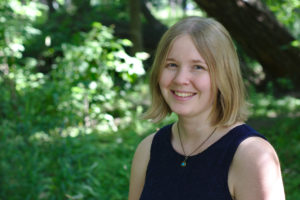My Vision of Driving—yes, you heard me right!
A decade ago, if you had told me I could write, edit and publish an entire document on a touch screen device with braille and a screen reader and a simple piece of glass, and that I could do my grocery shopping with the touch of an app, bank independently, call myself an Uber, or simply start my smart coffee maker from my iPhone, I’d have stared at you in open-mouthed incredulity. Communicators in Star Trek couldn’t do some of those things! Okay, the Enterprise didn’t have Amazon, but whatever. You get my point.
I have been thinking a lot lately about the possibility of smart-driving cars after a recent program on the topic on CBC Radio’s Spark (a show that discusses all kinds of technological innovations.) Anyone who knows me well knows that I really want to be in that driver’s seat—I mean, I have driven, and it’s cool.
So, what if I really could drive with the aid of technology. I mean, imagine voice activating your Alexa and saying “Alexa, order me a driverless car.” Then, she’d reply, “OK, I’ve contacted the database and sent you a driverless car; it will be here in 8 minutes. Please be waiting on the marked part of your driveway so the car can pull up safely. The car will wait until you activate the lock with the facial recognition you provided. Then, please use your fingerprint to unlock and activate the vehicle.”
And, so, what if this really happens? What if one day, I step out of my house, get into the driver’s side of my car (yes, the driver’s side) and stow my white cane safely beside me. Then, I start my car by voice print, or fingerprint. I tell my car to put on CBC Radio one or two and plug in the coordinates using my Apple GPS. My Apple watch uses haptic vibrations to tell me whether we’re turning right or left. A voice of my choice (maybe Apple’s Alex or Amazon’s Alexa) tells me where we are headed and the traffic conditions.
“Heavy traffic ahead, rerouting to Gardener Expressway.”
I have the GPS programmed to point out all coffee shops and stop with the simple voice command, “Coffee shop, need to off-rout.”
I run a couple errands, meet a friend, and as the car is driving, I periodically check the Braille Display touch map to make sure we’re okay, but the driverless car does the work for me. I sit back and read a book, listen to music, write a work report, or check out the latest CBC news on Twitter.
The thing is? That technology is starting to exist. And it’s not just for blind people. Universal inclusion was this thing people talked about over dessert 20 years ago that seemed like such a utopian idea. Now? It’s everywhere. Driverless cars are already on our roads. For some further reading on self-driving cars, check out: Driverless car benefits | Automated Transport | Self-driving Vehicles and Advantages of driverless cars – Business Insider
The days when my disability is the barrier society perceives it to be are ending, but we’re not quite there yet! We just must land this. And technology is light years ahead of the political arena to market the technology. Technology is ahead of society’s ability to let disabled people participate equally without power struggles and fear. Technology is also ahead of our own fears of our bodies, our disabilities, and our ability to say “disabled” and not have it be a bad, negative connotation word. I’m blind. I’m disabled. That does not prevent me from doing things. Those words are just legal labels and associated differences in my rights. But we’re not there yet. But, what excites me is that there is the potential to be there.
So, watch out, because I will be driving that self-driving car! See you on the road!
